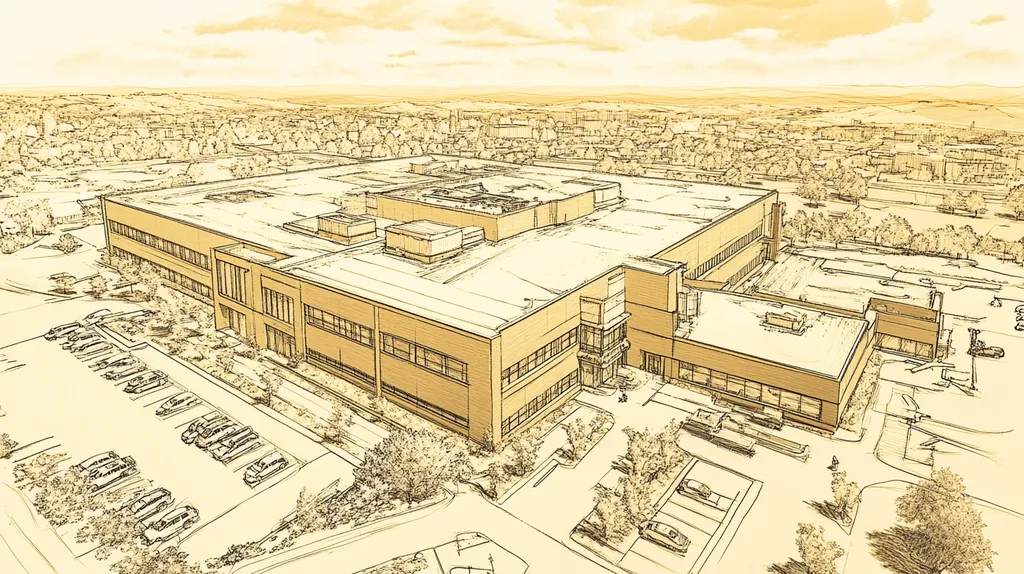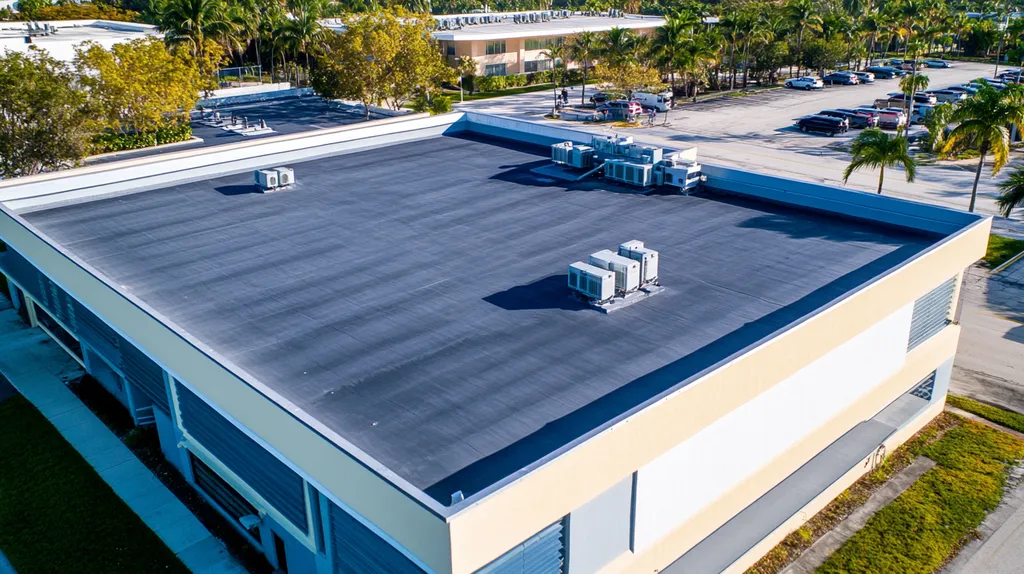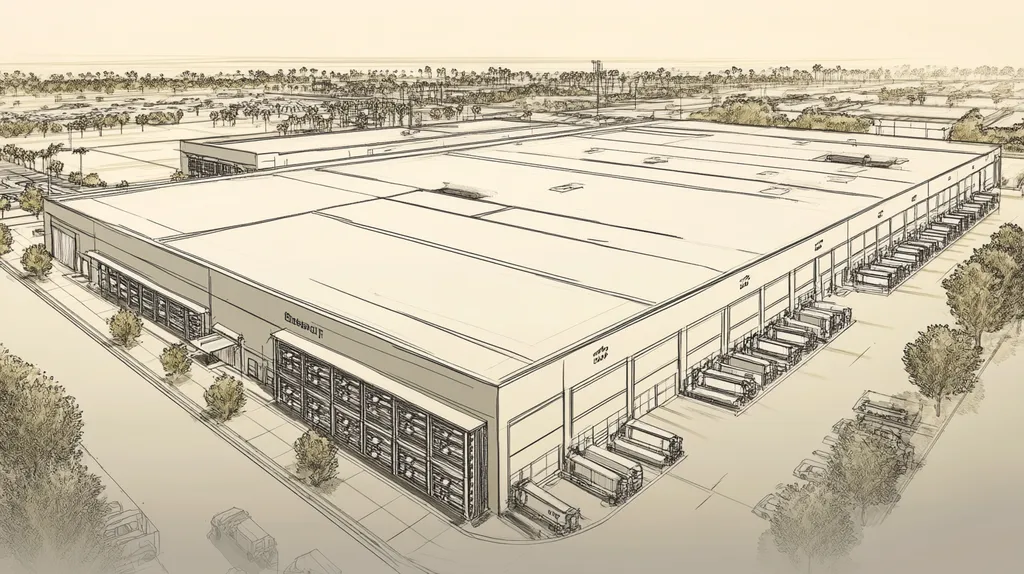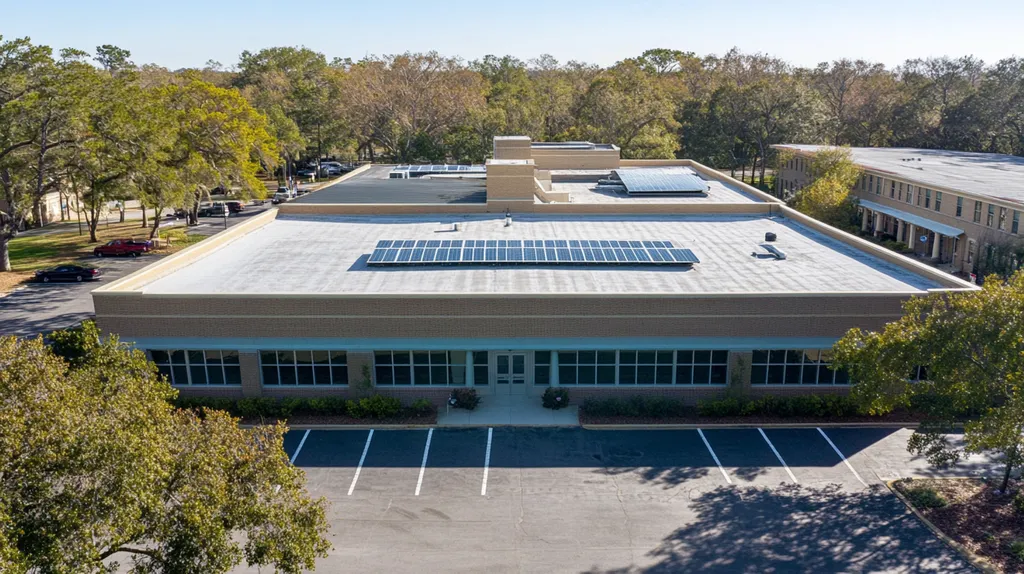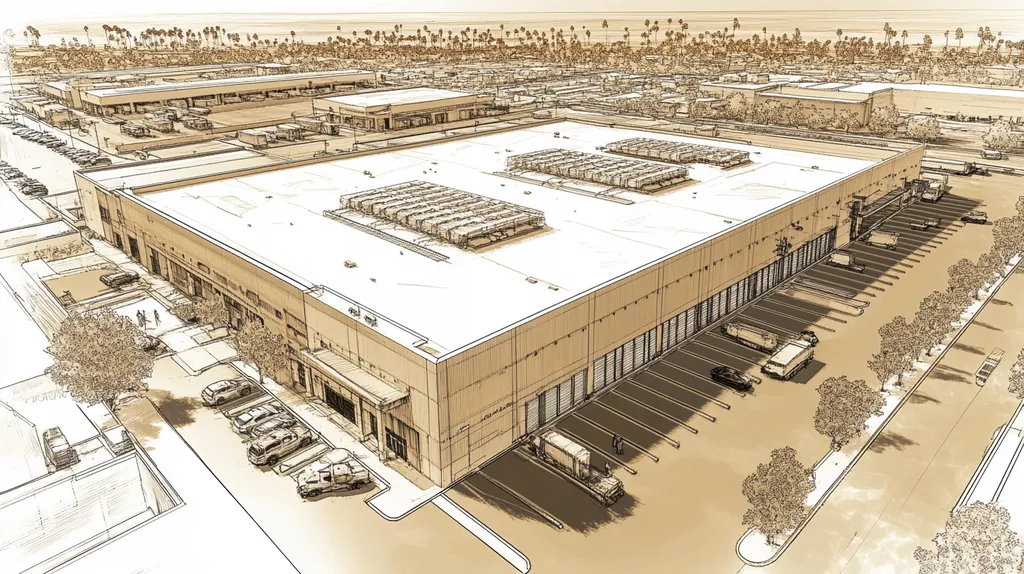In today’s industrial building landscape, the choice of ventilation materials can make or break both environmental impact and bottom line. With commercial buildings accounting for nearly 40% of global energy consumption, selecting eco-friendly materials for roof ventilation systems has become a critical decision.
From recycled components to innovative biomaterials, sustainable options are revolutionizing how industrial facilities manage airflow and energy efficiency. Yet many property owners struggle to navigate the complex world of green building materials.
This comprehensive guide breaks down everything you need to know about eco-friendly industrial roof ventilation – from material selection to real-world applications and long-term cost implications.
SECTION 1: THE BASICS EXPLAINED
In today’s industrial roofing landscape, choosing the right materials is more important than ever. Eco-friendly materials in roof ventilation systems aren’t merely a passing trend—they’re essential for promoting sustainability while saving on operational costs. With buildings responsible for nearly 40% of global carbon emissions, the case for adopting environmentally-conscious solutions is clear and urgent.
For building owners, grasping the concept of eco-friendly materials can be a game changer. It means taking significant steps toward reducing their environmental impact and curbing energy expenses. In this section, we will explore what eco-friendly materials entail, why they are crucial for your building, and how they work in tandem with industrial roof ventilation systems.
What It Is (In Plain Language)
Eco-friendly materials for industrial roof ventilation systems are sustainable alternatives designed to maximize energy efficiency. This category can include recycled products, non-toxic substances, and materials sourced from renewable resources. For instance, insulation made from recycled denim not only performs well but also helps cut down on landfill waste.
Additionally, materials like cool roofing membranes can reflect solar energy, helping to maintain a cooler building temperature. By using such materials in ventilation systems, property owners can optimize airflow, which ultimately leads to reduced energy use.
Choosing eco-friendly options can also open the door to government incentives aimed at encouraging sustainable practices. This can lower initial costs while enhancing the property’s overall value, making it a wise financial choice.
In essence, eco-friendly materials combine innovation with sustainability, marking them as essential choices for modern industrial roofing.
Why It Matters (To Your Building)
Choosing the right materials directly impacts the performance and lifespan of industrial roof ventilation systems. Eco-friendly materials can significantly boost building efficiency, leading to drastic reductions in heating and cooling expenses. A robust ventilation system not only minimizes moisture-related issues, such as mold growth, but also helps maintain a comfortable indoor climate.
Moreover, adopting sustainable materials can enhance indoor air quality, which is vital for employee health and productivity. A well-ventilated space contributes to a comfortable environment, which, in turn, can reduce employee absences due to health issues.
Investing in eco-friendly roofing materials can also bolster a company’s reputation. As consumers increasingly support businesses that actively engage in sustainable practices, this commitment can provide a competitive edge.
These considerations make eco-friendly materials not just a choice but an essential strategy for industrial property owners.
How It Works
Eco-friendly materials operate by enhancing the natural processes of ventilation and insulation. Products like reflective roofing materials help combat heat absorption, allowing buildings to stay cooler, which leads to lower energy costs and a smaller carbon footprint.
Well-designed ventilation systems facilitate airflow, preventing moisture buildup and ensuring a healthy indoor environment. Utilizing sustainable materials in these systems reinforces their role in reducing environmental impact.
Furthermore, eco-friendly insulation materials help regulate temperature swings, creating a more stable indoor environment throughout the year. Building envelopes constructed with these materials can significantly enhance energy efficiency.
Incorporating these innovative practices into roofing systems is more than just a technical imperative; it’s a forward-thinking strategy that aligns with broader global sustainability efforts. A commitment to using eco-friendly materials not only addresses immediate needs but also contributes to the ongoing conversation about environmental responsibility in the industry.
SECTION 2: PRACTICAL APPLICATIONS
The need for eco-friendly materials in industrial roof ventilation systems is more pressing than ever. With the construction industry accounting for nearly 39% of global carbon emissions, shifting to sustainable practices can significantly lessen this burden while reaping economic rewards. For property owners and facility managers, understanding the practical applications of these materials is essential to boosting their roofing systems. This section delves into common applications, ideal times for implementation, and the dynamic interactions these materials have with existing systems.
Common Uses & Examples
Eco-friendly materials have found their stride in industrial roof ventilation systems. Options like TPO (Thermoplastic Olefin) and EPDM (Ethylene Propylene Diene Monomer) membranes are not only popular but also smart choices for insulation and energy efficiency. They play a pivotal role in reducing overall energy consumption, proving that sustainability can indeed save on costs.
Consider green roof systems, which incorporate living plants to absorb CO2 and enhance thermal performance. When used alongside traditional ventilation, these systems boost air quality and can drastically cut energy usage. A prime example is a flat-roofed warehouse sporting a green roof; it can lower indoor temperatures and ease the burden on HVAC systems.
Advanced technologies, such as wind turbines and solar-powered vents, further showcase the potential of eco-friendly materials. These innovative systems harness renewable energy to optimize airflow and minimize reliance on fossil fuels. Choosing sustainable materials and technologies isn’t just an option; it’s a pathway to a greener future.
When You Need It Most
Recognizing the right moments to implement eco-friendly materials can maximize their benefits. Industrial facilities with high traffic, like manufacturing plants, stand to gain immensely from enhanced ventilation—especially during peak production times when air quality can dip dangerously.
Furthermore, buildings in urban areas or those subject to strict emissions regulations should act swiftly to meet local compliance standards. By transitioning to sustainable materials, property owners demonstrate their commitment to environmental responsibility, boosting their organization’s reputation.
Major events, such as roof replacements or extensive renovations, are prime opportunities for integrating eco-friendly materials. Upgrading during these times not only optimizes investments but also leads to long-term energy savings while easing construction waste.
In short, timing is everything when it comes to leveraging the benefits of sustainable roofing solutions, making informed decisions critical.
Interactions With Other Systems
The effectiveness of eco-friendly materials in roof ventilation systems increases when integrated with other building systems. For example, combining advanced insulation with sustainable roofing can enhance energy efficiency, leading to substantial savings on heating and cooling.
Moreover, a well-coordinated relationship with HVAC systems allows for better airflow distribution, resulting in greater overall comfort for occupants. By incorporating smart controls, facilities can fine-tune ventilation rates based on real-time environmental data.
Additionally, aligning eco-friendly roofs with rainwater management systems can further bolster sustainability efforts. Roofs constructed from these innovative materials can easily connect to rainwater harvesting setups, enhancing resource management.
Ultimately, thoughtful planning and seamless integration with various systems can create a powerful synergy, magnifying the advantages of eco-friendly materials in industrial roof ventilation.
SECTION 3: KEY TERMINOLOGY DECODED
Navigating the language of eco-friendly materials for industrial roof ventilation systems is critical for making smart choices. Misunderstanding key terms can lead to costly errors in material selection, ultimately inflating operational expenses. Take “thermal transmittance,” for example; if property owners don’t understand it, they might choose ineffective materials that drive up energy costs. This section aims to clarify essential terms, demystify industry jargon, and simplify measurement and units, empowering decision-making.
Essential Terms Explained
Eco-friendly materials come with terminology that highlights their advantages. First up is “recycled content,” which refers to materials reprocessed from pre-existing products, reducing waste in landfills. Then we have “sustainability,” describing a material’s ability to meet current needs without compromising future resources—essential for long-term planning.
Another key concept is “life cycle assessment” (LCA). This process evaluates a material’s environmental impact from its production to its disposal. Knowing about LCA enables property managers to select materials that provide lasting benefits.
Lastly, let’s talk “reflectivity.” This term signifies how much sunlight a roofing material reflects, which can enhance energy efficiency. Materials with high reflectivity can drastically lower cooling expenses, making them ideal for industrial roofs.
Industry Jargon Translated
Industry jargon might seem daunting, but understanding it is essential for effective communication. For instance, “ventilation rate” measures the volume of air that flows through the roof system, significantly affecting indoor air quality and comfort. Grasping this term helps facility managers make informed choices about air exchange rates.
Another important phrase is “thermal envelope.” This indicates the layers of materials that govern heat retention and loss. A well-designed thermal envelope is crucial for energy efficiency, impacting heating and cooling costs directly.
Finally, “moisture barrier” refers to materials that effectively prevent water vapor from reaching the insulation layer, which can lead to expensive damage. Selecting the right moisture barrier can extend the roof’s lifespan, saving money in the long run.
Measurement & Units Simplified
Familiarity with measurement units can dramatically influence material selection. Take the “R-value,” for example; this measurement indicates thermal resistance—essentially how well a material resists the flow of heat. Higher R-values mean improved insulation, leading to energy savings.
Lastly, “decibels” measure noise levels within roofing systems. Eco-friendly materials that register lower decibel readings contribute to more comfortable work environments, positively influencing employee productivity.
SECTION 4: DECISION FACTORS
In the fast-paced world of industrial operations, selecting eco-friendly materials for roof ventilation systems is not just a choice—it’s a necessity! With studies revealing that sustainable roofing can slash energy costs by up to 30% over time, the stakes are high. Property owners and facility managers must carefully evaluate factors such as cost, performance, and durability to make smart choices that balance environmental stewardship with operational effectiveness.
Cost Considerations
At first glance, the price tags on eco-friendly roofing materials may appear daunting, often higher than traditional options. But don’t let initial costs cloud your judgment! It’s essential to look beyond what you pay upfront and consider the long-term savings on energy bills that accompanied the choice of sustainable materials.
Performing a lifecycle cost analysis can illuminate the true value of your investment. Take, for example, a green roof—it might demand a heftier initial outlay, yet it typically requires lower maintenance and increases the time between replacements. These factors collectively contribute to enhanced cost efficiency.
Moreover, many states and local governments are rolling out incentives and rebates to support the adoption of eco-friendly materials. This financial assistance can significantly relieve the initial hit to your budget and encourage sustainable upgrades.
Understanding the total cost of ownership reveals that opting for eco-friendly materials is not just economically viable but a forward-thinking investment that aligns with a greener future.
Performance Trade-offs
When sifting through roofing materials, it’s crucial to prioritize performance without sacrificing sustainability. Eco-friendly options, from cool roofs to reflective membranes, are tailored to boost energy efficiency.
These materials excel in regulating indoor temperatures, reducing reliance on heating, ventilation, and air conditioning systems. For instance, a reflective roof can dramatically decrease cooling bills during the sweltering summer months, allowing operations to run smoother and more efficiently.
However, it’s essential to assess how various green materials perform in different weather scenarios. Some options may excel in thermal performance but struggle under heavy rain or snow loads.
Conducting a comprehensive performance assessment will ensure that the eco-friendly choice not only meets sustainability aims but also upholds the operational integrity vital for smooth facility management.
Lifespan & Durability Factors
Durability is a key factor in the eco-friendly materials selection process for roof ventilation systems. Many sustainable options promise extended lifespans, lowering the frequency of replacements and repairs.
Consider thermoplastic olefin (TPO) and ethylene propylene diene monomer (EPDM), both known for their impressive resilience against UV radiation and drastic temperature fluctuations. These materials are built to withstand harsh weather, resulting in reduced maintenance efforts.
It’s vital to align chosen materials with the environmental conditions of the facility. Investigating local climate patterns can aid in selecting eco-friendly materials that offer the best durability for your specific needs.
Ultimately, investing in a well-constructed and sustainably sourced roof not only enhances building longevity but also reinforces environmental stewardship, making a compelling case for this forward-thinking approach.
SECTION 5: COMMON CHALLENGES
In the journey toward implementing eco-friendly materials in industrial roof ventilation systems, several critical hurdles can emerge. Research indicates that approximately 30% of existing ventilation systems fail due to poor airflow management. This not only hampers building efficiency but can also inflate energy costs. Recognizing these challenges is pivotal for making informed choices about sustainable roofing solutions. In this section, we will tackle common issues, highlight warning signs, and discuss preventative strategies that can enhance system performance and longevity.
Frequent Problems & Solutions
One prevalent issue is the deterioration of traditional materials that may fall short of modern environmental standards. Over time, systems built with non-eco-friendly plastics can degrade, resulting in airflow blockages. By switching to sustainable options like recycled aluminum or bio-based plastics, property owners can significantly reduce maintenance issues and boost overall performance.
An equally pressing challenge is improper installation, which often leads to insufficient ventilation. Without adequate airflow, indoor temperatures can climb, leading to elevated energy consumption. To counter this, hiring a skilled contractor who specializes in eco-friendly materials ensures that installations are executed properly, ultimately reducing long-term operational costs.
Moisture accumulation is another critical concern frequently overlooked. Poor ventilation can allow humidity to build up, creating ideal conditions for mold and corrosion. Incorporating moisture-resistant eco-friendly materials can alleviate these risks, safeguarding both the building and the health of its occupants.
Warning Signs To Watch For
To maintain efficient ventilation, property owners must stay alert for signs of performance issues. A sudden spike in energy bills is often a telltale sign that something is amiss. If costs increase without a corresponding jump in usage, it’s crucial to assess the efficiency of your ventilation system.
Condensation on interior surfaces is another red flag indicating inadequate airflow. This can lead to potential mold growth and further health hazards. Keep an eye out for moisture stains and musty odors, as these can signal an urgent need for system evaluation.
Additionally, noticeable temperature fluctuations between different areas in the building may suggest poor airflow distribution. If specific locations are consistently uncomfortable, it could be time to reevaluate the ventilation components and consider eco-friendly upgrades for better efficiency.
Preventative Approaches
Regular maintenance is indispensable for avoiding complications within industrial roof ventilation systems. Scheduling routine inspections empowers property owners to identify and resolve issues early, ensuring systems operate smoothly and efficiently.
Installing monitoring sensors can provide real-time data on airflow performance, allowing for quick adjustments as necessary. This proactive approach enables facility owners to fine-tune ventilation and maximize the effectiveness of their materials.
Finally, educating facility managers on the benefits of sustainable materials fosters proactive decision-making. Understanding the advantages of options such as reflective roof coatings and environmentally-friendly insulation can lead to improved long-term outcomes, solidifying the choice for eco-friendly solutions.
SECTION 6: NEXT STEPS & RESOURCES
In a world where building emissions play a key role in climate change, choosing eco-friendly materials for industrial roof ventilation systems has never been more urgent. With buildings accounting for nearly 40% of energy-related carbon emissions, property owners are in a powerful position to make a difference. This section emphasizes actionable steps, essential questions to ask providers, adherence to industry standards, and resources for further learning to facilitate informed decision-making.
Questions To Ask Providers
When evaluating potential providers for eco-friendly materials, property owners should start by asking targeted questions. It’s important to know where the materials come from and whether they meet recognized sustainable certifications. Understanding a product’s lifecycle can reveal its true environmental impact.
Also, inquire about energy efficiency ratings to see how materials contribute to improved ventilation while slashing energy costs. Providers should provide clear evidence of the long-term advantages of their offerings.
Don’t forget to ask about their installation practices! It’s crucial that providers use methods that minimize waste and environmental impact. A trustworthy provider will be transparent and willing to share relevant performance data pertaining to eco-friendly materials.
Additionally, requesting case studies or examples of past projects can illustrate the effectiveness and durability of these materials in real-world scenarios.
Industry Standards & Guidelines
Ensuring that eco-friendly materials meet industry standards is crucial for performance and safety. The American Society for Testing and Materials (ASTM) sets forth guidelines for various roofing materials, emphasizing those that foster sustainability.
Moreover, the Cool Roof Rating Council provides standards aimed at enhancing energy efficiency through reflective roofs, which can significantly improve ventilation systems. Familiarity with these guidelines allows property owners to select materials that adhere not only to regulations but also enhance overall functionality.
Understanding the U.S. Green Building Council’s LEED certification can also guide sustainable decision-making. This certification promotes eco-friendly roofing practices that contribute to a property’s sustainability goals.
By integrating these standards into planning, property owners can elevate their market value while showcasing their commitment to environmental stewardship.
Further Learning Simplified
Staying up to date on eco-friendly materials is essential in the ever-evolving construction landscape. Start by visiting reliable industry websites such as the National Roofing Contractors Association or the U.S. Department of Energy. These platforms offer guidelines, insightful articles, and the latest updates on sustainable practices.
Participating in workshops or webinars can also expand knowledge about recent innovations in roofing materials. Engaging with industry experts illuminates practical applications and future directions in sustainable roofing.
Furthermore, online courses focused on green building practices provide in-depth insights. Several educational institutions offer programs dedicated to environmentally responsible construction techniques, which are crucial for all stakeholders involved.
Finally, consider networking with fellow professionals in the industry. Collaborating with peers fosters valuable exchanges of information and shared experiences concerning eco-friendly practices.
Looking Ahead
With industrial buildings responsible for 40% of global energy consumption, the shift toward eco-friendly ventilation materials isn’t just trendy—it’s imperative for survival in today’s market.
From recycled components to innovative biomaterials, sustainable options are transforming how facilities manage airflow while reducing operational costs by up to 30%.
Property owners who continue using conventional materials risk falling behind competitors, facing increased regulatory scrutiny, and missing valuable tax incentives.
The future of industrial roofing clearly points toward sustainability, with market projections showing a 300% increase in eco-friendly material adoption by 2030.
The question isn’t whether to embrace sustainable ventilation materials—it’s how quickly you’ll adapt to stay competitive in an increasingly environmentally conscious marketplace.
FREQUENTLY ASKED QUESTIONS
Q. What are eco-friendly materials for a commercial roof?
A. Eco-friendly materials are sustainable alternatives that maximize energy efficiency in industrial roofing. They include recycled products, non-toxic materials, and renewable resource-sourced items like eco-friendly insulation and reflective membranes. Such materials not only contribute to reduced carbon emissions but can also save operational costs.
Q. How can I apply eco-friendly materials to my industrial roof?
A. You can apply eco-friendly materials during major renovations or roof replacements. Consider systems like green roofs, TPO, and EPDM membranes to enhance insulation and reduce energy consumption. Upgrading at these opportune moments can lead to long-term savings and environmental benefits.
Q. What is thermal transmittance in industrial roof systems?
A. Thermal transmittance refers to how efficiently a roofing material can retain or lose heat. Understanding this term helps property owners select materials that minimize energy costs by enhancing overall efficiency. A lower thermal transmittance value indicates better insulation performance.
Q. What cost factors should I consider for my commercial roof?
A. When evaluating cost factors for eco-friendly roofing materials, consider upfront prices against long-term savings on energy bills. Perform a lifecycle cost analysis to better understand potential expenses over time. Additionally, factor in available government incentives that can ease initial financial burdens.
Q. What common challenges face eco-friendly roofing systems?
A. Common challenges include improper installation leading to insufficient airflow and moisture buildup. Traditional materials may degrade over time, causing performance issues. Regular maintenance and using sustainable options can help mitigate these challenges and ensure effective ventilation and energy efficiency.
Q. What questions should I ask providers about eco-friendly materials?
A. Inquire about material sourcing, sustainability certifications, energy efficiency ratings, and installation practices. Request details on the lifecycle of products and ask for case studies illustrating their past project successes. This information can guide your decision-making process effectively.
Q. How do eco-friendly materials improve indoor air quality?
A. Eco-friendly materials enhance air quality by reducing moisture and preventing mold growth. Their effectiveness in regulating temperature and improving ventilation ensures a comfortable environment. This not only promotes employee health but can also lead to increased productivity and reduced absences.


